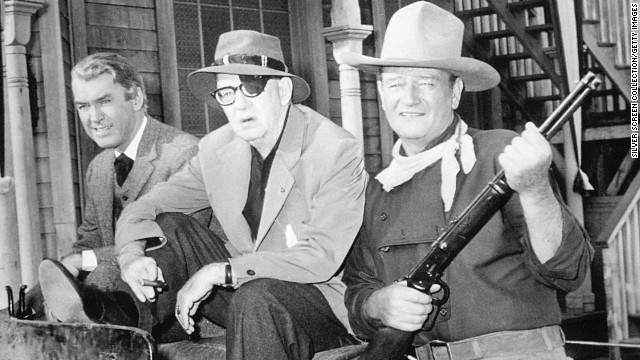- Back to Home »
- The woman who wrote Liberty Valance

- Dorothy Marie Johnson yearned to break into the boy's club of Western story writers
- Her story "The Man Who Shot Liberty Valance" was turned into a film with top Hollywood stars
- Greene: She knew how to draw readers into a tale and keep them hanging until the end
Editor's note: CNN Contributor Bob Greene is a best-selling author whose 25 books include "Late Edition: A Love Story"; "When We Get to Surf City: A Journey Through America in Pursuit of Rock and Roll, Friendship, and Dreams"; and "Once Upon a Town: The Miracle of the North Platte Canteen."
(CNN) -- No one ever handed her anything.
She never had it made.
Born in Iowa in 1905, an only child, she soon moved with her parents to Montana. As she grew up, she developed a love of reading and an interest in writing and submitted stories to her small-town newspaper. She studied English at college in Montana; she briefly and unhappily married and then divorced. She worked whatever jobs she could find. Her husband had built up numerous debts, including gambling losses; she vowed that she would make good on all of them, and she did.

She sold some stories to the Saturday Evening Post, using her full name as a byline: Dorothy Marie Johnson. She moved to New York, found work at the Gregg Shorthand Co., and eventually became the editor of a women's-interest magazine.
But she was homesick -- and she yearned to write a different kind of story. In New York, she would go to the public library to read up on the saga of the West and would go to the movies to watch thrilling films on that same theme.
She missed Montana, and what she most wanted to do was write Westerns.
The authorship of Westerns -- tales of cowboys and rustlers and settlers and the rough-hewn world around them -- had traditionally been a men's club. Zane Grey, Max Brand, Owen Wister, Luke Short, Jack Schaefer, Louis L'Amour -- right up to today, those are the kinds of names most frequently associated with famous Western novels. There didn't seem to be much room for a Dorothy.
She didn't care. She knew she was good enough to succeed.
Here are six words for you:
"The Man Who Shot Liberty Valance."
She wrote it. She changed her byline to Dorothy M. Johnson, feeling that Dorothy Marie sounded too frilly; she wrote the short story that was turned into one of the greatest Western movies ever made. A men's club?
John Ford, the director of the 1962 film, and John Wayne, James Stewart and Lee Marvin, the stars, welcomed her into their own club. So did Gary Cooper, who starred in another movie based on one of her stories: 1959's "The Hanging Tree." And Richard Harris, who starred in 1970's "A Man Called Horse."
Last Sunday's column, about the immortality that the highest level of artistry confers upon the artist, centered on the life of Vincent van Gogh, but it also mentioned some authors whose work will long endure. In between the names of F. Scott Fitzgerald and Philip Roth, I placed the name of Dorothy M. Johnson.
A number of you asked who she was.
I'm glad you did. I was kind of hoping you would.
Because, in addition to the wonderful talent she possessed, she is a prime example of how, if you set your heart to it, you have a chance to accomplish just about anything.
She died in 1984, at the age of 78. According to the obituary published in The New York Times, she wrote 17 books, more than 50 short stories and many poems and magazine articles. After she moved back West, she taught college writing courses. The Western Writers of America bestowed upon her their highest honors.
Her writing was so clean, so spare -- she knew just how to draw her readers into a tale and keep them hanging on right up to the last word in the last sentence of the last paragraph. Westerns may not be as popular as they once were, but beautiful writing is eternal.
Your public library, if you're lucky, has some Dorothy M. Johnson books; I think you'll find them a treat. KUSM, the public-broadcasting station in Bozeman, Montana, put together an affectionate 27-minute documentary on her life called "Gravel in Her Gut and Spit in Her Eye." If you'd like to see it, here it is.
Because she seemed to enjoy putting unexpected twists into her plots, and because we're talking about "The Man Who Shot Liberty Valance," I'll end this with a story about the movie I think she might have liked.
During my years of musical travels, I became friends with Gene Pitney, the singer whose hits included "It Hurts to Be in Love," "Twenty-Four Hours from Tulsa," "Town Without Pity" and, of course, "The Man Who Shot Liberty Valance." Once you hear that song, you never forget it.
Pitney told me that he constantly heard two things from fans. Either they would say:
"I thought your song was one of the best parts of the movie."
Or:
"I was watching 'The Man Who Shot Liberty Valance' on TV last night, and they cut your song out of it. They must have had to edit it for time."
Both sets of fans, Pitney said, were wrong.
"I thought I was recording it for the movie," Pitney said.
He was justifiably excited about the prospects. With that cast and that director, the film was destined to be a big hit.
During the recording session, a friend of Pitney's left the studio, went outside for a few minutes and saw a marquee on a movie theater. The person came back, Pitney said, and broke the news to him:
"In the middle of the recording session, I found out that the movie had already come out."
To say that made him a little depressed is an understatement.
"Here's a movie with Jimmy Stewart, Lee Marvin and John Wayne -- and the song doesn't get into the movie," he said.
But people continue to think they heard it there. For a long time, Pitney would gently set the questioners straight. By the time he died in 2006, though, he often just smiled and let them believe what they wanted to believe.
He was living up to a line with which every Dorothy M. Johnson fan -- and every fan of "The Man Who Shot Liberty Valance" -- is quite familiar:
When the legend becomes fact, print the legend.
Follow us on Twitter @CNNOpinion.
Join us on Facebook/CNNOpinion.
The opinions expressed in this commentary are solely those of Bob Greene.







